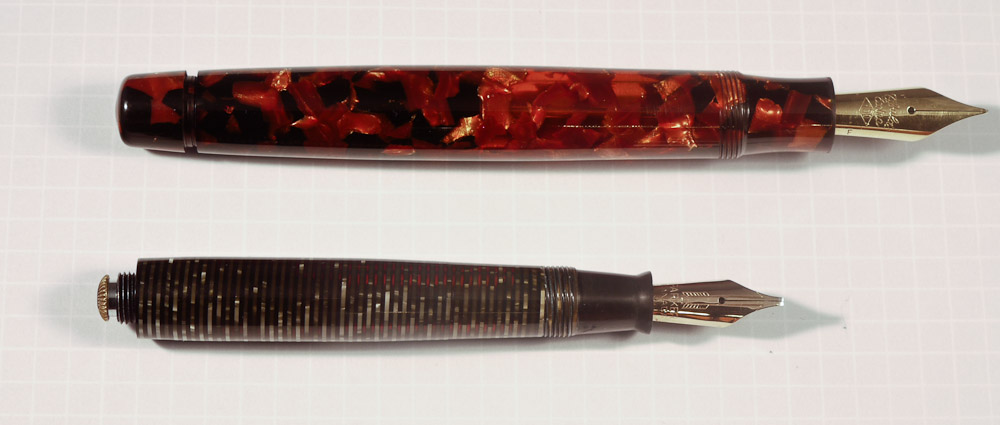The 1920s were the formative period for modern advertising with copy like “somewhere west of Laramie”, slogans like “the pause that refreshes”, and catchy Burma-Shave verse on sequential signs along roads to take advantage of the new mobility. The decade that followed is more exciting to me because it heralded the idea that if products were flashy and futuristic they would be easier to market. Parker didn’t let this slip by them and started a trend in fountain pens where the job done by a few simple parts was replaced by an amalgam of complexity.
Billed as being “like a pen from another world” the Parker Vacumatic was introduced in 1933 sporting a new filling system to replace the old button filler associated with their famous Duofolds. The filling system (usually also called Vacumatic) was a marvel of modern design. Instead of a bladder to hold the ink the barrel itself was a reservoir and even had clear sections to let you keep tabs on your ink supply. Some might complain that it really offered no functional benefit over existing lever and button fillers and they have a point. It actually requires more effort to fill a Vac then the single push or pull of the other systems. Also the pen as mentioned is complex and a lot harder to repair then the old standards. None-the-less this filling system was in use into the late 1940s on the Parker 51.
Let’s take a quick look how the filler works on these pens. The idea is that a rubber diaphragm is flexed up and down by a spring loaded plunger. When released the upward motion of the mechanism creates a vacuum in the barrel which draws ink up through a breather tube attached to the feed of the pen. The downward stroke pushes the air out of the pen hopefully not expelling as much ink as it sucked in. You need to do this 5 to 10 times to fill the pen so it’s a bit like winding a watch. The up side to your work is that the pen can hold quite a bit of ink.
After the Snorkel this is my favorite filling system mainly because I like crazy contraptions. I have a few Vacs and really wanted the Bexley owner’s club pen of a few years back because it actually used recycled filling systems salvaged from broken Vacumatics. However, I really never thought anyone would take the time and effort to design a new pen using this 70 year old filling principle. You probably guessed right away I was wrong.
Tibaldi was the name of an old, defunct Italian pen manufacturer. In the go-go premium pen environment near the end of the 20th century a company formed to resuscitate the brand (as was the trend) and designed a new range of writing instruments. Before this version of Tibaldi (the name has been reused yet again) went under they created a number of interesting and sought after pens. One of them is the beautiful Iride pictured here. This pen is made from red marbled celluloid and like pens of yore has transparent areas in the front of the barrel to let you see your ink. It also apes the Vacumatic in the odd decision to use the same filling system. Yes, it’s been redesigned with an integrated blind cap and a plunger larger in girth but it works the very same way and it holds a lot of ink.

I find it a bit of a mystery why Tibaldi emulated the very first Parker Vacumatic filling unit and not the later ones. Those early “lock-down” units had the pen’s owner retract the plunger into the pen and twist it to lock. The downside is that this last push makes some ink comes out of the pen meaning some lost capacity and that you’d better have it over the ink bottle. Parker introduced the improved “speedline” filler a few years into production, which stayed in the extended position when not being used.
No matter what the Iride is a gorgeous pen with red islands floating in the barrel glinting back at you when the light hits them. I like the simple monochrome nib and the fact the section is of the same material as the barrel. It works and writes well and is really reminiscent of an older pen.
Just to illustrate the similarities between my Iride and an early Vacumatic filler I’ve take some side-by-side images. Both plungers store in the down position via a detent on the Vac and threads on the Tibaldi.
When Tibaldi went out of business a lot of pens were assembled from left over parts and sold. Mine is one of those and I was lucky to find it. The rubber diaphragm in these fillers eventually wears out in time and I hope there’s a lot of life left in my Iride since it’ll be rather hard to find a replacement.



